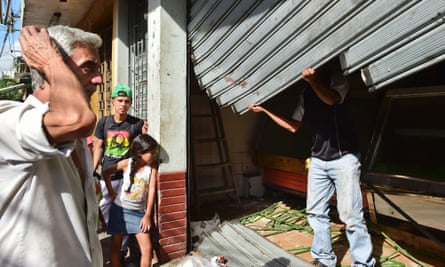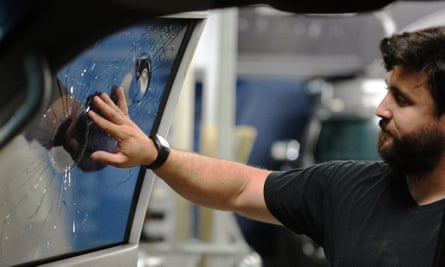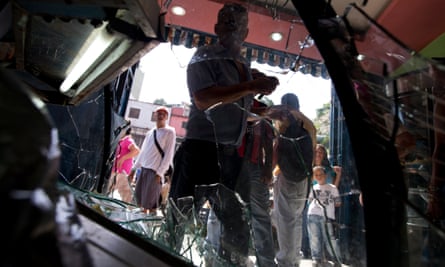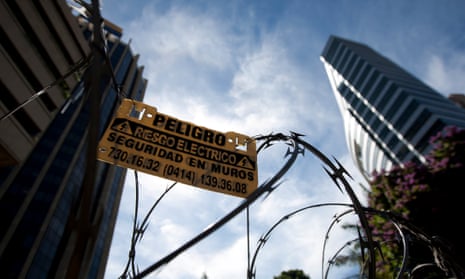The last thing Corina expected on the night she and her two children were carjacked was for her kidnappers to scold her.
“It’s extremely irresponsible of you to be driving at this time of night, ma’am,” Corina recalled her captor saying. “You shouldn’t be going around in this tiny car at night.” He then kicked her out of the car, took her cash and left her and her children on the streets of Caracas in the dead of night.
The story is just one of many on a list that has gone viral in Caracas about criminals advising their victims on how to avoid falling prey to their traps.
Although the article, published by El Estimulo newspaper, has a humorous tone, it highlights a fact of life in the world’s most dangerous city. A self-imposed curfew rules over the Venezuelan capital where, according to Organised Crime Observatory, 3,102 murders took place in 2016 alone.
Only the brave walk the streets of Caracas after sunset, when the dizzying frenzy of the daytime city gives way to an eerie stillness as residents seek refuge indoors: the wealthy hide inside their gated communities and the poor lock the doors to their makeshift zinc-roofed homes. A handful of speeding cars tear through half-empty roads and solitary figures walk briskly down dark pavements.
It was not always this way. Dubbed the Paris of South America, Caracas benefited from a strong oil sector and an influx of European immigrants in the 1950s. The city boomed for decades, feeding on foreign investment and building modern infrastructure. Mass housing projects began to materialise as residents from the countryside arrived in search of a better life.
But in the 1980s, oil prices collapsed and decades of government mismanagement led to soaring inflation and an economic crisis that has only worsened since the death of Hugo Chávez four years ago.
Shortages in the capital have caused a desperate lack of food and access to basic medical supplies, prompting a humanitarian crisis and testing the already delicate social fabric: according to polling firm Datalanalisis, 95.1% of the population is unhappy with the state of the country.

Meanwhile, a cocktail of poverty, corruption and the propagation of illegal firearms have peppered the capital with booby traps in the form of malandros (thugs). This has forced the estimated 3.5 million Caraqueños – and the city itself – to adapt.
Maylen Rincon, 54, points towards the towering metal barrier in front of her block of flats in east Caracas. “This fence was erected five years ago,” she says. “People now use three to four locks on their doors.”
She had left her building early that morning to see a group of young men chasing a thief down the road. “I like the theatre, the cinema, but not anymore,” she says. “We don’t even go to shopping malls and we’ve stopped wearing nice clothes, watches or using mobile phones [on the street].”
“We no longer have a life,” adds her elderly neighbour.
Further down the road, Andres Goudett is busy sweeping the floor of his clothing shop. He explains that he only stays open until 5pm, because heading out after sunset means risking your life.
“It’s a pretty dangerous area,” says the 43-year-old. “[Thieves] don’t care about killing you to take your phone. Twenty years ago you could go out, walk around.”
“This is a country of great architects,” says Venezuelan architect and urban designer Hannia Gomez, recalling the Caracas that once was. “[But] the development of the city has been a wild one.”
Beneath the backdrop of the Avila national park, a lush mountain range that frames the skyline and separates Caracas from the Caribbean sea, lies a city split in two.

A divisive fault line runs through east and west Caracas, forming a border between the “dangerous” areas and the “safe” ones. West Caracas is home to slums such as Catia and 23 de Enero – interminable clusters of redbrick or colourful makeshift homes, where rundown buses laden with passengers labour though narrow, unlit streets. Market stalls line the chaotic roads, while black market vendors have sprung up to sell staple necessities at exorbitant prices.
East Caracas, by contrast, primarily houses the city’s middle and upper classes in high-rise buildings and lavish homes. The roads are dotted with lofty trees and expensive cars. It’s a reality that belongs only to a very small minority.
These areas have essentially gone into lockdown. In the wealthy Country Club neighbourhood, sturdy walls, barbed wire and electric fences now block off homes and gardens that were once visible from the street.
In the slums, there is less money for protection, although shards of glass embedded in concrete attempt to serve the same purpose. But that didn’t stop thieves from breaking into 21-year-old Gustavo’s supermarket. “We have fences and cameras, but they broke down the back wall with a metal rod,” he says. His uncle recently returned to his home town in China after being shot on a busy commercial street in Caracas.
“It affects different classes in slightly different ways, but it’s certainly affecting everybody,” says Phil Gunson of the International Crisis Group, who has lived in Venezuela since 1999. “If you live in a poor area, even if you manage to get home before dark, you have to get up so early in the morning to leave your house – and many robberies and assaults take place in the early dawn.”
In one gated community in the north of the city, residents have installed a machine that reads visitors’ ID numbers. As a result, what seems like an interminable queue of cars waits patiently each day to be allowed inside.

“Fences have always been there. However, they have become higher and people have added barbed wire,” says architect Maria Isabel Espinosa Marturet. “They’re reminiscent of prison or a concentration camp.”
This “architecture of fear” – a term coined by scholar Tunde Agbola – has seen not only the bolstering of walls but also the use of a variety of security systems, including dogs, shotguns, two-way radios to communicate with police officers, and if you can afford it, private security.
At times on quiet streets you can hear the “click, click, click” of the electric wires running across tall walls. Some shop owners choose to keep their doors locked, buzzing clients in once they have been vetted. Even the windows and some balconies of high-rise buildings are fenced off with metal bars, like teeth snarling down on the city.
Crime has affected the city’s architecture. While once Venezuelan homes were designed homes based on comfort and Caribbean-style open spaces, today the focus is on security.
But it’s not just about buildings. Nicolas Kasang, an urban development consultant, has argued that this type of urbanisation has had a negative impact on the city’s social dynamic. “[It] fragments public space, breaks down social cohesion, perpetuates widespread insecurity, and, ultimately, diminishes the overall quality of urban life,” writes Kasang.
Caraqueños from all walks of life have become accustomed to fearing the “other”.
“There’s mistrust in everyone,” says Osnaider Vizcaino, a 22-year-old graphic designer with multiple tattoos, who says people on the street often go out of their way to avoid him. “I’m not a particularly posh-looking guy, even though I live in a posh area. But I prefer to be feared rather than look like a target – that’s the reason I wear chains and have tattoos. Even though I look like this and try to be confident on the street, I do fear other people.”
Caracas was never exactly safe, but tales of glitzy nights out and partygoers stumbling merrily through the streets at 4am are recounted like distant memories of a bygone era. One nightclub owner, who asked to remain anonymous, says that nightlife in the once-buzzing capital has dwindled considerably since he first bought the club 17 years ago.

“The sense of insecurity has multiplied and our target clientele has left the country, particularly over the past three years,” he says.
“Crime has had a major impact in terms of people’s willingness to go out, see friends – ordinary social interactions which would take place outside,” Gunson adds. “[Nightlife] is taking place in people’s homes, because that’s the only way people feel safe.”
Indeed, today many Caraqueños are more likely to gather in houses – and often opt to sleep over. If they do choose to travel at night, they are likely to do so in convoys of three or four cars, and under no circumstances stop at red lights for fear of carjackings.
“Everybody does [sleepovers],” says 22-year-old Emiliana Lante. “If you’re at a gathering that ends at 2am or 3am, you’d rather stay in that house because that’s when kidnappers will have enough time to abduct you and ask for ransom.
“I only drive until 8pm,” she adds. “After that time, I stay over at my friend’s home, or my parents pick me up and escort me [in convoy].”
The steady deterioration of the city’s public lighting has also served as a blanket of immunity for thieves and kidnappers.
“The light situation has been dramatic for all of Caracas,” says Marturet. “Both in the richer areas and in the slums, people use the lights in their homes to illuminate the street.”

Even in broad daylight, one of the greatest sources of anxiety for Caraqueños is getting stuck in traffic. Lante has had her mobile phone stolen three times while stuck in traffic – twice by the same thief.
The richest can afford to armour their vehicles and tint their car windows, filling the already chaotic streets of Caracas with tank-like SUVs. But those who can’t afford to pay an average of $25,000 to stay safe in an armoured vehicle are forced to play Russian roulette with their belongings, and sometimes with their lives.
The police say they are doing the best they can in a difficult situation. “We’ve increased our patrolling since last year: there are now at least eight police officers per five square kilometres,” says Einer Giuliani, head of security of El Hatillo, one of the city’s five municipalities.
Other measures taken to fight crime are the government’s controversial Operation Liberation and Protection – aimed at cracking down on gang crime, but often accused of human rights abuses – and bettering relations and communication between Venezuela’s fragmented police agencies.
But as crime seems to worsen, some Caraqueños have devised innovative ways to continue enjoying life’s small pleasures. They combat the loss of public space and dwindling nightlife by relying on safety in numbers.
Joggers form social media groups to run in the evenings. Initiatives such as Trasnocho Cultural offer theatre and art lovers the chance to see plays and exhibitions during matinee times, and be home by sunset. Meanwhile, schemes such as #ccsen365 bring together large groups of Caraqueños to rediscover their love of the city and its history through guided tours.
As Caracas readies itself to celebrate its 450th anniversary in July, mayor Helen Fernández is encouraging organisations such as Caracas en 450 to plan art exhibitions, flash mobs and marathons, in an attempt to reacquaint the millions of Caraqueños with their city.
“Cities are alive and constantly changing, but sometimes change can mean progression and other times it can mean regression,” says architect and Caraqueña Maria Isabel Espinosa Marturet. “When you can’t walk calmly down the street, or when you can’t sit in a coffee shop because criminality is just around the corner – that’s when your rights are breached.”
Follow Guardian Cities on Twitter and Facebook to join the discussion, and explore our archive here

Comments (…)
Sign in or create your Guardian account to join the discussion